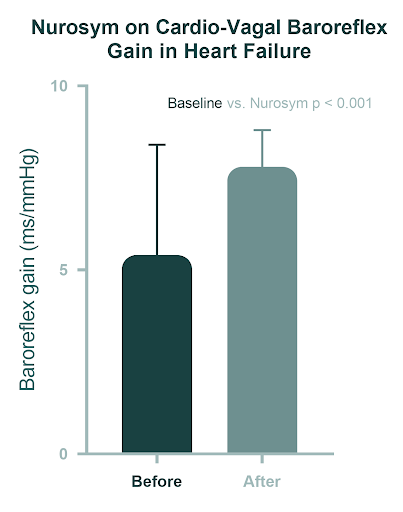Effects of Auricular Vagal Neuromodulation Therapy (AVNT) on Cardio-Baroreflex Gain in Chronic Heart Failure Patients
Published in: Clinical Autonomic Research Journal
Abstract
The study investigated the acute effects of short-term Burosym auricular vagal neuromodulation therapy (AVNT) on cardio-vagal baroreflex gain and heart rate variability (HRV) in patients with chronic heart failure (CHF) and left ventricular ejection fraction (LVEF) < 50%. A single-session, crossover design was employed, with participants receiving right- and left-sided AVNT randomly. AVNT, especially right-sided, significantly improved cardio-vagal baroreflex gain, showing a mean increase of 1.9 ± 1.6 ms/mmHg from baseline (p < 0.001). No changes were observed in heart rate, blood pressure, or respiratory rate during the stimulation phases. These results suggest that AVNT is a promising non-invasive neuromodulation strategy to improve autonomic function in CHF.
Background and aims
Autonomic imbalance characterised by heightened sympathetic activity and reduced vagal tone is a key factor in the progression of CHF. Reduced cardio-vagal baroreflex gain is a strong predictor of poor outcomes in CHF. The invasive nature of current therapies, such as baroreceptor activation therapy (BAT), limits their clinical application. Auricular vagal neuromodulation therapy (AVNT) has emerged as a non-invasive alternative to enhance vagal tone and improve autonomic balance. This study aimed to evaluate the acute effects of right-sided versus left-sided AVNT on cardio-vagal baroreflex gain and HRV in patients with CHF and LVEF < 50%.
Methods
A single-session, crossover design was implemented in CHF patients (LVEF 40 ± 5%, 65 ± 8 years, 63% male). Each participant underwent right- and left-sided AVNT in randomised order, separated by a 10-minute recovery period. Stimulation was delivered via the Parasym Device (1 mA below discomfort threshold) to the tragus. Signals including ECG, beat-to-beat blood pressure, and respiratory rate were recorded. Cardio-vagal baroreflex gain was calculated as the ratio of SDNN (standard deviation of normal-to-normal intervals) to the standard deviation of systolic blood pressure (SDsBP). Statistical analyses were conducted using ANOVA for repeated measures with Bonferroni correction for post hoc comparisons.
Results
Right-sided AVNT increased cardio-vagal baroreflex gain consistently across subgroups defined by sex, CHF aetiology, and LVEF category.

Right-sided AVNT significantly increased cardio-vagal baroreflex gain by 34% from baseline (∆ 1.9 ± 1.6 ms/mmHg, p < 0.001), outperforming left-sided AVNT, in patients with chronic heart failure. A one-way ANOVA for repeated measures was performed, with Bonferroni correction for post hoc pairwise comparisons.
HRV parameters indicated a potential trend toward vagal predominance during right-sided AVNT, though changes were not statistically significant after a single stimulation. Vital parameters, including heart rate and blood pressure, remained stable throughout the protocol, and no adverse effects or discomfort were reported during the stimulation phases.
Conclusion
This study demonstrates that acute right-sided AVNT improves cardio-vagal baroreflex gain, which could benefit patients with systolic CHF by enhancing autonomic regulation, reducing sympathovagal imbalance, and alleviating symptoms such as fatigue and reduced exercise tolerance. Additionally, safety, feasibility, and efficacy outcomes suggest that AVNT is a safe, non-invasive adjunctive therapy with the potential to address key challenges in CHF management, including symptom control and treatment precision.
Keywords
Vagus Nerve Stimulation (VNS); Parasympathetic Nervous System; Baroreflex Gain; ECG; Exercise Tolerance